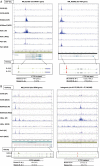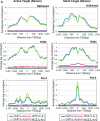Characterization of STAT6 target genes in human B cells and lung epithelial cells
- PMID: 21828071
- PMCID: PMC3190958
- DOI: 10.1093/dnares/dsr025
Characterization of STAT6 target genes in human B cells and lung epithelial cells
Abstract
Using ChIP Seq, we identified 556 and 467 putative STAT6 target sites in the Burkitt's lymphoma cell line Ramos and in the normal lung epithelial cell line BEAS2B, respectively. We also examined the positions and expression of transcriptional start sites (TSSs) in these cells using our TSS Seq method. We observed that 44 and 132 genes in Ramos and BEAS2B, respectively, had STAT6 binding sites in proximal regions of their previously reported TSSs that were up-regulated at the transcriptional level. In addition, 406 and 109 of the STAT6 target sites in Ramos and BEAS2B, respectively, were located in proximal regions of previously uncharacterized TSSs. The target genes identified in Ramos and BEAS2B cells in this study and in Th2 cells in previous studies rarely overlapped and differed in their identity. Interestingly, ChIP Seq analyses of histone modifications and RNA polymerase II revealed that chromatin formed an active structure in regions surrounding the STAT6 binding sites; this event also frequently occurred in different cell types, although neither STAT6 binding nor TSS induction was observed. The rough landscape of STAT6-responsive sites was found to be shaped by chromatin structure, but distinct cellular responses were mainly mediated by distinct sets of transcription factors.
Figures






Similar articles
-
Integration of cap analysis of gene expression and chromatin immunoprecipitation analysis on array reveals genome-wide androgen receptor signaling in prostate cancer cells.Oncogene. 2011 Feb 3;30(5):619-30. doi: 10.1038/onc.2010.436. Epub 2010 Oct 4. Oncogene. 2011. PMID: 20890304
-
Histone H3k9 and H3k27 Acetylation Regulates IL-4/STAT6-Mediated Igε Transcription in B Lymphocytes.Anat Rec (Hoboken). 2015 Aug;298(8):1431-9. doi: 10.1002/ar.23172. Epub 2015 Jun 22. Anat Rec (Hoboken). 2015. PMID: 25952120
-
Genome-wide approaches reveal functional interleukin-4-inducible STAT6 binding to the vascular cell adhesion molecule 1 promoter.Mol Cell Biol. 2011 Jun;31(11):2196-209. doi: 10.1128/MCB.01430-10. Epub 2011 Apr 4. Mol Cell Biol. 2011. PMID: 21464207 Free PMC article.
-
SATB1 packages densely looped, transcriptionally active chromatin for coordinated expression of cytokine genes.Nat Genet. 2006 Nov;38(11):1278-88. doi: 10.1038/ng1913. Epub 2006 Oct 22. Nat Genet. 2006. PMID: 17057718
-
Role of ChIP-seq in the discovery of transcription factor binding sites, differential gene regulation mechanism, epigenetic marks and beyond.Cell Cycle. 2014;13(18):2847-52. doi: 10.4161/15384101.2014.949201. Cell Cycle. 2014. PMID: 25486472 Free PMC article. Review.
Cited by
-
A comparison of the rest complex binding patterns in embryonic stem cells and epiblast stem cells.PLoS One. 2014 Apr 21;9(4):e95374. doi: 10.1371/journal.pone.0095374. eCollection 2014. PLoS One. 2014. PMID: 24752154 Free PMC article.
-
Aberrant transcriptional regulations in cancers: genome, transcriptome and epigenome analysis of lung adenocarcinoma cell lines.Nucleic Acids Res. 2014 Dec 16;42(22):13557-72. doi: 10.1093/nar/gku885. Epub 2014 Nov 6. Nucleic Acids Res. 2014. PMID: 25378332 Free PMC article.
-
MicroRNA-140 mediates RB tumor suppressor function to control stem cell-like activity through interleukin-6.Oncotarget. 2017 Feb 21;8(8):13872-13885. doi: 10.18632/oncotarget.14681. Oncotarget. 2017. PMID: 28099924 Free PMC article.
-
PI3K and STAT3: a new alliance.Cancer Discov. 2011 Nov;1(6):481-6. doi: 10.1158/2159-8290.CD-11-0218. Cancer Discov. 2011. PMID: 22348200 Free PMC article. Review.
-
Spatial Interplay between Polycomb and Trithorax Complexes Controls Transcriptional Activity in T Lymphocytes.Mol Cell Biol. 2015 Nov;35(22):3841-53. doi: 10.1128/MCB.00677-15. Epub 2015 Aug 31. Mol Cell Biol. 2015. PMID: 26324324 Free PMC article.
References
-
- Kaplan M.H., Schindler U., Smiley S.T., Grusby M.J. Stat6 is required for mediating responses to IL-4 and for development of Th2 cells. Immunity. 1996;4:313–19. - PubMed
-
- Shirakawa I., Deichmann K.A., Izuhara I., Mao I., Adra C.N., Hopkin J.M. Atopy and asthma: genetic variants of IL-4 and IL-13 signalling. Immunol. Today. 2000;21:60–4. - PubMed
Publication types
MeSH terms
Substances
LinkOut - more resources
Full Text Sources
Research Materials
Miscellaneous

